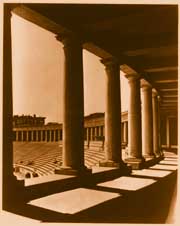

Not long after construction began for an athletic field at City College of New York, school officials conceived the idea of that same field serving as an outdoor concert hall during the summer months. The result, Lewisohn Stadium, named after its principal benefactor, Adolph Lewisohn, and modeled much along the lines of an ancient Roman coliseum, became that and much more. Lewisohn Stadium was for over forty years (1922 to 1964) the summer home of America's oldest symphony orchestra, the New York Philharmonic. More importantly, the Lewisohn concerts witnessed a particularly impressive and innovative array of talent, creative as well as interpretive. For nearly fifty years, audiences of all social and ethnic backgrounds attended concerts that, together, summed up much of the course of twentieth century American serious music at minimal cost for admittance. At 8:30 PM every summer night (seven days a week throughout the twenties and thirties into the later forties, from which point concerts were given only four or five times a week), Stadium audiences saw many of the finest conductors of the century direct the New York Philharmonic at Lewisohn Stadium (or the Stadium Symphony Orchestra, as they were called from 1951). Such maestros included regular conductors Willem van Hoogstraten (1884-1965) and Alexander Smallens (1889-1972), about whom little has been written thus far. Other podium legends included Pierre Monteux (1875-1964), Eugene Ormandy (1899-1985), Fritz Reiner (1888-1963), Sir Thomas Beecham (1879-1961), and, of course, such New York Philharmonic music directors as Leonard Bernstein (1918-1990), a child prodigy named Lorin Maazel (b. 1930), and, in his New York debut, Zubin Mehta (b. 1936). The finest instrumental soloists came to uptown New York during these summers, along with glamorous vocalists of the contemporary operatic stage. These performers constitute a summation of the twentieth-century American concert hall, brought together, as they were, by talent, politics, and the public's genuine hunger for musical culture.